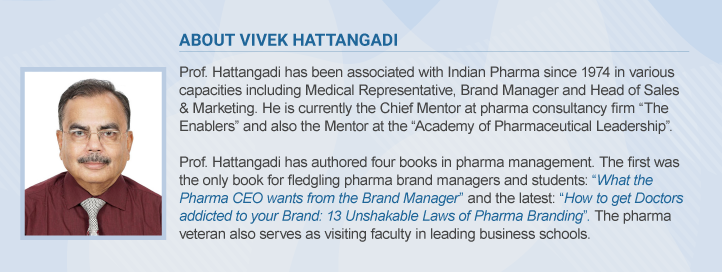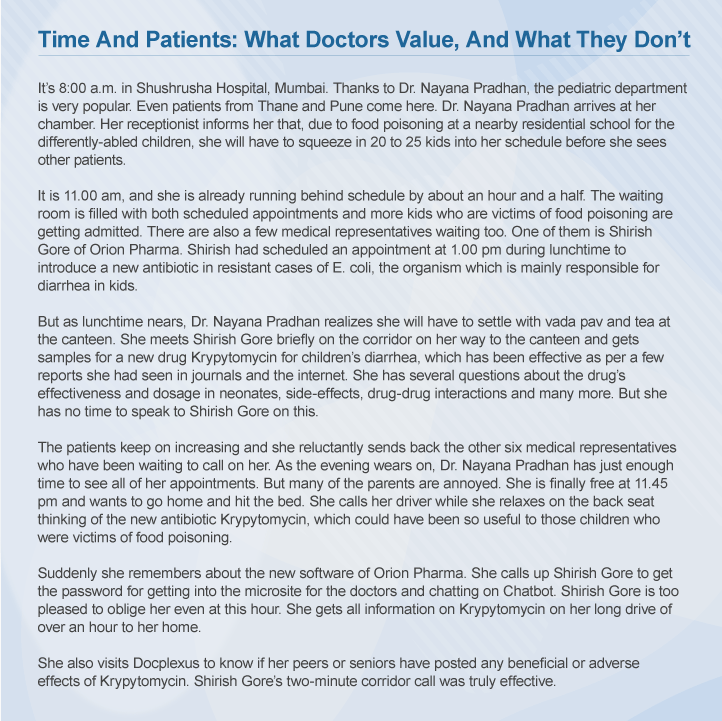
Indian Pharma Industry is facing changing times brought in by technological advancements, impending regulations, and medical discoveries, forcing organizations to revisit their traditional sales model. We talk to industry veteran Prof. Vivek Hattangadi on the evolving role of medical representatives in India and the best strategies to build a “future-ready” field force.

Interviewer: Prof. Hattangadi, you have been associated with the Indian pharma industry for over 4 decades. What major shifts have you observed over the years?
Prof. Hattangadi: The pharma landscape has undergone shifts in three key areas –
The changing market scenario
When I started my journey in the pharmaceutical industry in 1974, the market size was a mere Rs. 3,000 crores. MNCs dominated and only a handful of Indian companies existed. Products manufactured by domestic players were looked at with suspicion. At the end of the millennium, the market size grew to around Rs. 30,000 crores. Today it is a whopping Rs. 1.33 lakh crores.
In the initial phase of the growth, Ranbaxy and Cipla were the drivers. Eventually, they became names to be reckoned with, across the globe. Calmpose and Mebex were the two brands which catapulted them to fame. A little later emerged Dr. Reddy’s, Torrent Pharma and Lupin who took the Indian pharma industry by storm. And the 1990’s saw the emergence of young giants like Sun Pharma, Intas and Glenmark.
This millennium has seen the rise of strong regional players. For instance, Unison Pharma is the No. 1 company in Gujarat for the past many years, both as per shop audit and prescription audit. In the last decade and a half, we have seen specialty companies rising in niche segments. Palsons Derma and Curatio Healthcare operate only in the dermatology segment, Sundyota Numandis is trying to establish leadership in probiotics and Group Pharma is the emerging leader in the dental segment.
In the coming years, biotech companies may be growth drivers.
The shifts in marketing strategies and tactics
In the early days, Indian pharma was sales driven. The concept of brand management had not emerged. The national sales managers or the sales promotion managers were the key persons who developed medico-marketing promotional material. The focus was on the top line of the company and seldom on brands.
The seeds of brand management were sown in 1977 when Late Prof. Chitta Mitra and the Late Prof. Tarun Gupta started getting close to the minds of medical professionals. Late Prof. Chitta Mitra founded CMarc, the unique continuous prescription audit research agency. It set the stage for brand management in the Indian pharmaceutical industry.
Brand management system flourished through the 1980’s, 1990’s and the early part of this millennium. And then somewhere in 2005, the Special Economic Zones (SEZs) were created and the darkest period of pharmaceutical industry also commenced. Too many small-time entrepreneurs started taking advantage of the SEZs facilities. Fly-by-night operators called the “Propaganda-cum-Distributors” emerged. They had no vision. Their only aim was short-term gains! To combat them, ‘Transactional Marketing’ began raising its ugly head. (Transactional Marketing means trading freebies, goodies, and holiday cruises for prescriptions.) Hopefully, once the UCPMP is in place, the Indian pharma industry will see the re-emergence of brand-building days.
Therapy shift
In the 1970s and the early 1980s, the market was dominated by the acute therapy segment which virtually enjoyed a 90% share of the whole. Today the chronic and semi-chronic segments are growing fast. I predict that by 2030, they would have a 70% market share.
Nutritional supportive therapy is another segment I expect will flourish in the future. Products like Ala (Alpha Lipoic Acid) will be constant companions to diabetic patients, whether they are on oral hypoglycemic agents or insulin injections.
Interviewer: “Medical Representatives are the backbone of pharma marketing”. Will this statement continue to be valid in the coming years? Why?
Prof. Hattangadi: Medical Representatives and doctors enjoy a love-hate relationship with each other. Although medical representatives are failing to meet the new needs of doctors, they still are the face of pharma, and in-person meetings between the two are crucial touchpoints. I have seen doctors forging strong emotional bonds with field force, especially when the same medical representative engages with the doctor again and again. So yes, medical representatives will continue to remain the backbone of pharma sales and marketing for another century at least. But their roles and responsibilities will change to a large extent.
Medical representatives of tomorrow will move from being a mere message–deliverers to those who understand the doctor and the patient. Their role will continue to evolve as a new balance will appear between brand promotion and the promotion of the brand-linked solutions.
Future medical representatives would be required to articulate strong value propositions and tailor them to different stakeholders. They will need updated skills to match the doctors’ and the patients’ needs and enable patient-centric activities. This is all the more important as, in the near future, UCPMP will become mandatory and providing freebies and goodies, punishable. I hope Indian pharma takes concrete action on repurposing the utility and relevance of Medical Representatives.
Interviewer: What are the top challenges that pharma field personnel face today?
Prof. Hattangadi: The most unwelcome person in the doctor’s clinic is the medical representative. Neither the doctors nor the receptionists welcome him. In fact, he is looked at with suspicion even by the patients. And in this milieu, he is expected to make an effective prescription-generating call.
The availability of time during a call is a trial for him. What can that poor medical representative communicate in less than 30 seconds? Just 5 seconds per product? That is the time needed just to verbalize the brand name!
And the internal problem is lack of self-esteem. While the interaction between a medical representative and the doctor has to be essentially professional, the lack of training, substandard product knowledge and poor communication skills compound this problem, making the field force diffident.
Interviewer: What is the main reason for high attrition rate at the field force level? How can it be curtailed?
Prof. Hattangadi: Poor first-line leadership! A great number of first-line managers in our industry are not even aware of their roles, responsibilities, and accountabilities. They behave like uber-medical representatives. While first-line leaders are the managerial glue of a business, responsible for many critical day-to-day operations, the kind of training or coaching they get does not represent the importance they deserve.
When a new medical representative finds that there is nothing he can learn from his immediate boss, the natural tendency is to jump to a company where he either gets a better salary or opportunities to learn.
Toxic work environment – where dysfunction and tyranny reign – is another reason for attrition.
To address these issues, I endorse Business Guru Tom Peters’ advice: “The selection process for 1st line managers (1LMs) should be as rigorous as that of, say, vice presidents. “360”˚ evaluations are a must. Perhaps a selection committee should be appointed, which includes other 1LMs.”
Interviewer: Pharma representatives are often criticized for employing unethical means to drive prescriptions. How can organizations build a culture of compliance?
Prof. Hattangadi: Who is to be blamed for unethical practices? Culture starts at the top. How can we expect the field force to be ethical when the leadership isn’t? Often, the medical representatives are mere pawns in the DACG Strategy – the Dinners-Alcohol-Cruises-Gifts Strategy.
To build a culture of compliance, thinking and actions at the top have to change. Organizations need a couple of servant leaders who can act as catalysts of this new culture. They can become the tipping points and influence others. Servant leadership is now an acknowledged leadership style across the world and it is high time pharma C-suite embraces it.
Interviewer: What would be the best communications strategy to build long-term relations with KOLs in the future?
Prof. Hattangadi: KOLs are knowledgeable personalities with a huge sphere of influence. The communication strategy you can adopt is of an aggressive listener with a learning attitude. Not just learning, but even unlearning what you assume you know.
Listen and accept all feedback, including criticism. By doing so, you demonstrate tremendous respect and value you have for them. This can go a long way towards keeping them engaged and inspired to actively participate and cooperate with you.
Communicate frequently and through different channels with the KOLs. Vary the types of messages you send. Occasionally sprinkle them with small anecdotes or even relevant science-based humor. Remember, they are human beings first, KOLs later.
Interviewer: What role has digital technology played in improving pharma marketing outcomes? Can online touch points benefit offline marketing initiatives?
Prof. Hattangadi: Digital technology has improved the efficiency of pharma marketers. Consider the Field Force Automation tools. I recall as a medical representative, writing daily reports, monthly business reviews on paper using three carbon sheets was an ordeal. And then as a District Manager, analyzing the reports of the medical representatives, missed calls, repeat calls details, missed call percentage, call average, call coverage…What a time-consuming job it was! Today you get all these in a jiffy on your mobile app. Graphical representations help the first-line managers in the superior analysis.
Digital solutions are also empowering field force to succeed with their offline activities. Following a case study from my book “13 UNSHAKABLE LAWS OF PHARMA BRANDING: HOW TO GET DOCTORS ADDICTED TO YOUR BRAND” shows how –

Interviewer: Above case study seems to be the perfect example of the Phygital approach to pharma marketing of which you are a strong advocate. Why do you think Phygital is the best way forward? What are the key success factors of a Phygital marketing strategy?
Prof. Hattangadi: Phygital is a term that describes blending digital experiences with physical ones – Physical plus Digital and holds high value in this age of customer-centricity and customer experience. Experts predict that our literal and virtual worlds will soon get so intertwined that future generations will cease to distinguish between the two. In pharma context, as the channels of interaction with doctors proliferate, it will become important for marketers to combine all these channels in a frictionless and seamless manner. Phygital marketing will also be a crucial lever to support the field staff in building robust brands.
The first step towards Phygital success is complete mastery of physical and digital marketing. While most pharma marketers and brand managers dominate the offline realm, they still do not have an inkling of what digital marketing entails. Many are yet to realize the potential of doctor-community portals like Docplexus. And a majority fails to appreciate that going digital can steer patient-centric marketing and drive future business. Hence, efforts should be made to enhance the Digital Quotient of everyone in sales and marketing.
Phygital marketing would also involve the adoption of augmented reality (AR). Marketers can leverage AR to inform and educate doctors on the latest advances in medical devices and diagnostic tools.
Interviewer: Lastly, what advice would you give Pharma leaders aiming to build a ‘’future-ready’’ field force?
Prof. Hattangadi: Indian pharma is grappling with poor quality of field personnel. This is mainly because of lack of training and support from companies. The kind of salaries offered is also an entry barrier for talented people into this profession.
So, I would advise leaders to be proactive in recruiting the right talent, nurturing, developing, and compensating them.
With the evolving role of the medical representatives in the new era of patient-centric marketing and phygital marketing, pharma captains must ensure that they adopt digital marketing strategies that support the field staff and help them take the brand to the next level.
First-line leaders are the ones who drive brand strategy execution. Brand Managers and First-line Managers build brands in tandem and hence up-skilling them continuously can help build strong brands and a healthy organization. So, leaders must invest in quality training programs for their first-line leaders and brand managers.
Besides, the nuances of pharma brand management, brand managers have to learn social skills too. And one of them is to influence people over whom they have no authority. Knowing how to build, influence and lead the field without title or authority, is now a workplace necessity for pharma brand managers. That’s how you inspire them to execute strategies.
I strongly recommend that both sales & brand professionals develop 6 critical skills – Acquired Intelligence, Business Intelligence, Curiosity Quotient, Digital Intelligence, Emotional intelligence, and Spiritual Quotient.
Previous Episode of PharmaWise – Customer Experience in Healthcare: Interview with Pranav Kumar, Chief Experience Designer, Praakamya
